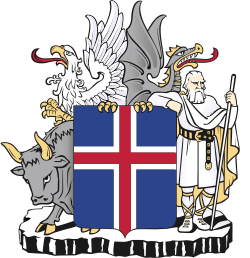Coat of arms of Iceland
| Coat of arms of Iceland | |
|---|---|
 | |
| Armiger | Republic of Iceland |
| Adopted | 1 July 1944 |
| Shield | Azure, a cross gules fimbriated argent |
| Supporters | Landvættir: A bull (Griðungur), a rock giant (Bergrisi), a griffin (Gammur), and a dragon (Dreki) |
| Compartment | Pahoehoe lava block |
| Coat of arms of the President of Iceland | |
|---|---|
 | |
| Armiger | President of Iceland |
| Adopted | 1944 |
| Shield | Azure, a cross gules fimbriated argent, charged with a white square with the full achievement of the national coat of arms. |
The coat of arms of Iceland displays a silver-edged, red cross on blue shield (blazoned: Azure, on a cross argent a cross gules). This alludes to the design of the flag of Iceland. The supporters are the four protectors of Iceland (landvættir) standing on a pahoehoe lava block.[citation needed] The bull (Griðungur) is the protector of southwestern Iceland, the eagle or griffin (Gammur) protects northwestern Iceland, the dragon (Dreki) protects the northeastern part, and the rock-giant (Bergrisi) is the protector of southeastern Iceland. Great respect was given to these creatures of Iceland, so much that there was a law during the time of the Vikings that no ship should bear grimacing symbols (most often dragonheads on the bow of the ship) when approaching Iceland. This was so the protectors would not be provoked unnecessarily.[1]
The landvættir (“land wights”) also decorate the obverse (front) of the Icelandic króna coins, but animals of the ocean (fish, crabs, and dolphins) appear on the reverse (back). The Icelandic presidency uses a swallowtailed Icelandic flag with the coat of arms. The National Commissioner of the Icelandic Police uses a white flag with the coat of arms, when the use of the State flag is not warranted, and some other state services do as well.
History
Iceland has historically had various distinct coats of arms:
- The first one is believed to have been a shield with six blue stripes and six silver stripes, possibly signifying the 12 þings of the Icelandic Commonwealth.
- The second one is believed to be the one that was given to Earl Gissur Þorvaldsson by the King of Norway, Hákon Hákonarson, in 1258. It was patterned on the King's own coat of arms, exchanging the colours of the shield with the colour of the lion and adding the blue and silver stripes of the previous coat of arms.
- Circa 1500, the Icelandic coat of arms became a crowned stockfish (a beheaded and eviscerated codfish that is spread open to be dried) on a red shield. It is known as the Þorskmerkið (“the cod markings”) and the fish was depicted occasionally in a variant form.
- On October 3, 1903, the coat of arms of Iceland was changed to a white falcon on a blue shield. It remained in use until the first version of the coat of arms with the landvættir became official on February 12, 1919, representing the Kingdom of Iceland under the Danish Crown. This lasted until Iceland became a republic.[2]
- When the republic was declared on June 17, 1944, the coat of arms was redesigned; removing the Danish crown and reforming the earlier design of the landvættir.
-
The coat of arms of the Icelandic Commonwealth
-
The coat of arms of the Earldom of Iceland from 1262
-
The coat of arms under Danish rule, ca. 16th century – 1903
-
The coat of arms from 1903-1919
-
The coat of arms of King Christian X of Iceland from 1918 to 1944 and of Denmark from 1903 to 1947. Iceland is represented by the silver falcon in the lower left corner. The falcon was removed from the Danish arms in 1948.
-
The coat of arms of the Kingdom of Iceland from 1919 to 1944
-
Tapestry hanging in Rock Island State Park, Wisconsin, USA
See also
References
- ^ "History". Icelandic Coat of Arms. Reykjavik: Prime Minister's Office. Retrieved 2009-05-22
- ^ Prime Ministry of Iceland. "Ágrip af sögu skjaldarmerkis Íslands (en. History of Iceland's coat of arms)". Prime Ministry of Iceland. Retrieved 2012-01-04.








